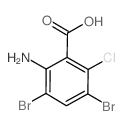2-Amino-3,5-dibromo-6-chlorobenzoic acid Suppliers
Total count: 1Updated Date: 2024-07-18 19:09:43

- China(Mainland)
- Contact: Yang
- Phone: 0086-021-52280163
- Email: sales@echemcloud.com
- Website: http://www.echemcloud.com
- Product Name: 2-Amino-3,5-dibromo-6-chlorobenzoic acid
- Updated Date: 2024-07-15 12:32:06
- Purity: 95.0%
- More information
Inquiry
2-Amino-3,5-dibromo-6-chlorobenzoic acid
- CAS Number: 143769-25-9
- Molecular Formula: C7H4Br2ClNO2
- Molecular Weight: 329.37300

Related product suppliers
Check more product suppliers